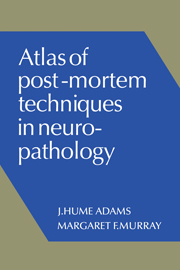6 - Muscle and Nerve
Published online by Cambridge University Press: 21 May 2010
Summary
Widespread sampling of peripheral nerve and muscle is essential in any patient thought to have had some type of neuromuscular disease. Many of the enzyme histochemical techniques routinely used in the examination of muscle biopsies can still be applied to muscle taken up to 24 to 36 hours after death. Thus some specimens of muscle taken post mortem should – properly labelled – be frozen in liquid nitrogen as quickly as possible. Most specimens of nerve and muscle are, however, simply fixed in neutral 10% formal saline. The selection of muscles and peripheral nerves to be examined will be determined by the clinical pattern of the disease, and prior discussion with the appropriate clinician is therefore essential. For a complete picture of peripheral neuropathy, cranial nerves, the trigeminal ganglia, posterior root ganglia and various peripheral nerves need to be examined. Once the posterior root ganglia in the lumbar and sacral region have been exposed (see Figs. 4.11 and 4.12) it is not difficult to continue the dissection distally to free all of the major nerves constituting the brachial plexus. Other nerves can be sampled individually.
This is a rather expert field, however, and before undertaking a post–mortem examination on a patient known to have some disorder of muscle or peripheral nerve it is advisable also to consult a neuropathologist. It may, for example, be important to attempt to examine the small muscles of the hand, and intramuscular nerves and end plates adjacent to the motor point in a muscle.
- Type
- Chapter
- Information
- Atlas of Post-Mortem Techniques in Neuropathology , pp. 91 - 95Publisher: Cambridge University PressPrint publication year: 1982



